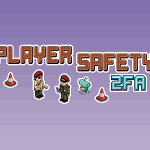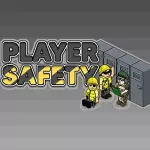
Written by: GwenDB94 / Graphics by: -Eils
This guide will cover how to design a wired system that checks for players in a given area and, if only a single team is present, changes a furni state indicating which team was present that can be listened to by other wired systems to award points to that team for having sole-control of a given area. This is a single-mechanism guide that covers the scoring mechanism used in USDF’s wired game “King of the Hill” first unveiled in Branch Wars 2023. It allows for awarding points for every X seconds of area-control by a given team, with 4 teams playing.
First, we will detail the “simpler” method of wiring this, for those unfamiliar with the new selectors and the various improvements included around June/July 2023. Then we will detail the more efficient method of wiring this using selectors. Lastly we will give an example of this wired in-use in a larger wired system to demonstrate its capabilities.
Wired Walkthrough
Furni List
1X Wired Trigger: Repeat Effect
6X Wired Trigger: Receive Signal
4X Wired Trigger: User Stuff Collision
4X Wired Condition: User Is on Team x
4X Wired Condition: Furni States And Positions Match
4X Wired Negative Condition: Furni states DOESN’T match
9X Wired Effect: Match Furni to Position & State
4X Wired Effect: Toggle Furni
2X Wired Effect: Send Signal
1+ Wired Effect: Change Furni Direction (depends on your game area size for number needed)
2X Antenna
4X Lamps/Lights/2-State furni
4X Multi-state Furni (variable, discussed later. Color Tiles used in this Guide)
Freeze/Banzai Tiles under your play area
Stacks Design
1 Stack each of the following:
Antenna
Wired Effect: Send Signal
Wired Effect: Change Furni Direction (may need multiple of these)
Wired Trigger: Repeat Effect
Antenna
Wired Effect: Send Signal
Wired Trigger: Receive Signal
Wired Effect: Match Furni to Position & State
Wired NEGATIVE Condition: Furni states DOESN’T match
Wired NEGATIVE Condition: Furni states DOESN’T match
Wired NEGATIVE Condition: Furni states DOESN’T match
Wired NEGATIVE Condition: Furni states DOESN’T match
Wired Trigger: Receive Signal
4 Stacks of:
Multi-State Furni (Color tiles in following screenshot)
Wired Effect: Match Furni to Position & State
Wired Effect: Toggle FUrni
Wired Condition: Match Furni to Position & State
Wired Trigger: Received Signal
4 Stacks of:
Lamp
Wired Effect: Match Furni to Position & State
Wired Condition: User is on team x
Wired Trigger: User Stuff Collision
Wired Configurations
Stack 1:
- Repeat effect set to 0.5 seconds with no advanced settings.
- Change furni direction linked to freeze/banzai tiles in play area, and direction set in such a way that it collides with everyone in the area you’re attempting to sense for team presence, and “when move is blocked” set to wait, with no advanced settings. In this example, the area within the ducks is the sensed “play area”, so the collision will trigger with anyone in the play area by linking to the indicated freeze tiles.
- Send Signal linked to antenna on this same stack, with 0 delay, and no advanced settings
Stack 2:
- Receive Signal linked to antenna in stack 1, no advanced options
- Send Signal linked to antenna on this stack, no advanced settings
Stack 3:
- Receive Signal linked to antenna in stack 2, and no advanced options
- 4 Negative conditions linked to all 4 lamps in stack 5s, with just 1 lamp turned on, and “Current Furni State” ticked, and no advanced options
- Match Furni to position and state effect linked to all 4 lamps on stack 5s in “off” state, “current furni state” ticked, and no advanced setting
Stack 4s:
- Receive Signal linked to antenna on stack 2
- Furni state condition linked to all 4 lamps, with 1 lamp on and 3 lamps off. Each of the 4 stack 4s should have a different “on” lamp, similar to the 4 negative conditions in step 3
- Toggle furni state linked to the multi-state tile on its own stack, set to toggle to next state, no advanced settings
- Match Furni to position and state effect linked to all 4 lamps on stack 5s in “off” state, “current furni state” ticked, and no advanced settings
Repeat this for each of the 4 stack 4s
Stack 5s:
- No settings needed for collision trigger
- Team condition set to 1 team per stack, so that all 4 teams have a stack of their own. In this guide, the lamps are color-coded and the team condition in each of the stacks is linked to the team color of the lamp on the top of the stack.
- Match effect linked to just the 1 lamp on the given stack, set to the on position, no advanced settings.
Repeat this for each of the 4 stack 5s.
Stack Descriptions
Stack 1 – runs the system every 0.5 second, to check the status of control of the designated area. Starts the collision stacks which check teams in the area, and sends a signal to the stacks that “listen” for single-team-control
Stack 2 – a “delay” stack for proper order of operations to ensure the collisions happen before first
Stack 3 – Resets the system if multiple teams are within the checked area, so nobody has control
Stack 4s – One per team, if team has sole control of checked area, changes the state of a multi-state furni that can then be used in other wired system to indicate “X team had sole-control for 0.5 seconds”
Stack 5s – Teams in area indicator. Refreshes every 0.5 second to re-check teams in area
As designed, this system will look at all players in the freeze tile area inside of the ducks, check what team they are on, and as long as only 1 team is in the area, will toggle a color tile for that team every 0.5 seconds to indicate that team has sole-control of the area.
Examples of Use
One use-case for this type of system is in a game like King of the Hill, where there are multiple teams attempting to score points by having control over a “hill”. If there are multiple teams in the area, neither team should get points. The system described above will track for every 0.5 seconds, any team that has full control of the given area. Using a color tile as the state-change furni means you can add a single point to a scoring system (either football scoreboards for points that don’t need to be tracked by wired or leaderboards, or by using give-points wired for systems that do need to be tracked) for every 0.5 seconds to 3.0 seconds. With a color tile having 7 unique states, 1 for the “starting” default state, and up to 6 0.5 second state changes.
In the system shown in later images and descriptions, we award a given team 1 point for every 3 seconds they have uncontested control of the hill (6 state changes). We add the system we wired today, to a simple football scoreboard toggle point system. When the color tile for a given team reaches green (the 6th state from the default “clear”), the scoreboard toggles, and it resets the color tile back to clear.
In the above image, the freeze team gates are added as a visual indicator of which team colors each color tile corresponds to, and there are the added football scoreboards, set as described earlier. In the following video, we have members from 2 separate teams “fighting” for control of the hill. When either team gets to 3 seconds of individual control, as indicated by the color tile reaching green, their scoreboard goes up a point, and the color tile is reset to its default “clear” state to begin counting again.




